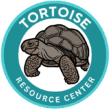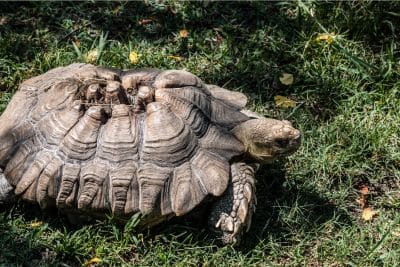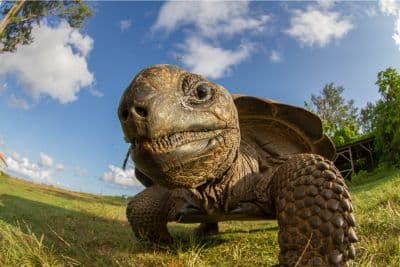The most common questions we get at The Tortoise Resource Center are about appropriate tortoise diets, and for good reason—getting nutrition wrong is one of the fastest ways to cause serious, often permanent health problems. That’s actually why we created our company, we were looking for a healthier food for our tortoises without fillers or preservatives.
Here’s what makes tortoise nutrition so stressful: feeding a desert tortoise like a forest species can kill it. Treating a Mediterranean tortoise like it needs the same diet as a tropical species causes metabolic disasters. Even well-meaning keepers who carefully research “tortoise diet” often end up following generic advice that doesn’t account for the massive differences between tortoise types. The result? Shell deformities, metabolic bone disease, kidney failure, and tortoises that live 20 years instead of 70. And that’s a shame!
The problem is that most nutrition guides treat all tortoises the same, when actually a sulcata from the African desert needs completely different foods than a red-footed tortoise from the Amazon rainforest or a Hermann’s tortoise from Mediterranean scrublands. These aren’t minor variations—we’re talking about fundamental differences in digestive systems, nutritional requirements, and what foods will either sustain or harm your tortoise.
This guide breaks down exactly what desert, forest, and Mediterranean tortoises need to eat, what they absolutely cannot have, and how to create species-appropriate diets that support healthy, long lives. You’ll learn why habitat matters more than you think, how to avoid the common feeding mistakes that cause permanent damage, and what to do when your specific tortoise doesn’t quite fit the standard categories.
- Why Tortoise Type Determines Everything About Diet
- Desert Tortoises: The Grass-Based Diet
- The Calcium-Phosphorus Ratio That Matters for All Tortoises
- Foods That Are Dangerous for All Tortoises
- Supplementation for All Tortoise Types
- Age-Based Feeding Guidelines
- Feeding Strategies That Prevent Problems
- Species-Specific Considerations
- Ready to Master Tortoise Nutrition?
Why Tortoise Type Determines Everything About Diet
Tortoises evolved over millions of years in dramatically different environments, and their digestive systems reflect those habitats. A desert tortoise has gut bacteria specifically adapted to break down tough, fibrous grasses with minimal water content. A forest tortoise has enzymes optimized for processing varied vegetation including some fruits and occasional protein. A Mediterranean tortoise has seasonal adaptations for both lush spring growth and dry summer survival.
When you feed the wrong diet for your tortoise’s type, you’re not just making a minor mistake—you’re asking their digestive system to process foods it literally cannot handle efficiently. Desert tortoises fed high-sugar fruits develop digestive upset and abnormal growth. Forest tortoises fed only dry grasses miss critical nutrients and moisture. Mediterranean tortoises given year-round rich diets can’t properly prepare for the hibernation their bodies expect.
Understanding your tortoise’s natural habitat isn’t academic—it’s the foundation for everything else. Before you can feed appropriately, you need to know whether your tortoise is a desert grazer, a forest forager, or a Mediterranean seasonal feeder. Get this wrong, and every other feeding decision will be wrong too.
Desert Tortoises: The Grass-Based Diet
Desert tortoises including sulcatas, Russian tortoises, and various North American desert species live in arid regions with sparse vegetation. These harsh environments shaped digestive systems optimized for high-fiber, low-protein, low-moisture diets consisting primarily of grasses and tough plants. We created our Sulcata Superfood Powder for these guys specifically!

Desert Tortoises
The Foundation: Grasses and Hay (75-80% of diet): This isn’t optional—grasses must form the overwhelming majority of what desert tortoises eat. Bermuda grass grows well in hot climates and provides the fiber content essential for digestive health. Buffalo grass is drought-resistant with good nutrient balance. Blue grama is native to arid regions and naturally appropriate. Timothy hay isn’t native to deserts but offers excellent high-fiber, low-protein content when fresh grasses aren’t available. Orchard grass hay is softer than timothy and makes a good alternative.
Alfalfa hay is controversial—it’s high in both protein and calcium, making it beneficial for juveniles in small amounts but potentially problematic for adults if overfed. Use sparingly or avoid entirely for mature desert tortoises.
Calcium-Rich Leafy Greens (15-20% of diet): Dandelion greens are calcium powerhouses, high in vitamin K and excellent for shell health. Turnip greens are rich in nutrients and low in oxalates, making them safe for regular feeding. Mustard greens should be offered in moderation due to higher vitamin A content. Endive adds variety without causing digestive issues. Collard greens are a staple that’s high in calcium and fiber.
Vegetables (5% maximum): Desert tortoises need minimal vegetables. Carrots contain beta-carotene beneficial for shell and skin health—serve shredded or finely chopped. Squash can be fed raw or cooked, providing different textures. Bell peppers are high in vitamins A and C but offer only occasionally. Cucumber isn’t nutrient-dense but provides hydration as an occasional treat. Avoid broccoli and cauliflower—they contain goitrogens affecting thyroid function.
Fruits (Occasional treats only): Fruits are not part of a desert tortoise’s natural diet and should be extremely limited. Their digestive systems can’t handle high sugar content well. If you offer fruit at all, limit to tiny amounts monthly—strawberries, cantaloupe, or papaya in small pieces. Remove apple seeds and serve small pieces to prevent choking. The temptation is strong because they love the sweetness, but resist—fruit causes digestive problems and abnormal growth.
Safe Flowers: Hibiscus flowers and leaves are beloved by tortoises and safe to offer regularly. Rose petals should be pesticide-free. Nasturtium flowers and leaves are high in vitamin C. Dandelion flowers are nutrient-rich if picked from chemical-free areas. Mint and basil can be offered sparingly.
For growing desert tortoises like baby sulcatas, ensuring proper nutrition ratios is critical. Our Baby Sulcata Superfood Powder is specifically formulated for desert tortoise species, providing the right protein-to-fiber ratios with appropriate calcium levels to support healthy growth without the risks that come from guessing at nutritional balance.
Forest Tortoises: The Varied Diet
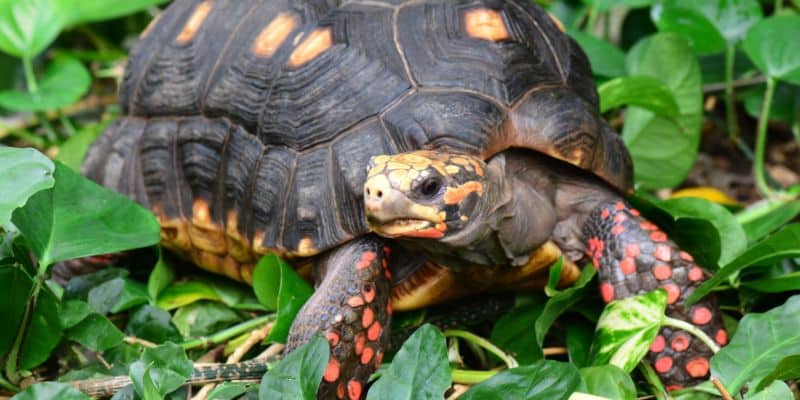
Forest tortoises such as red-footed and yellow-footed tortoises live in dense, humid tropical and subtropical environments. These lush conditions provide rich vegetation variety and occasional animal protein, creating completely different nutritional needs than desert species.
Leafy Greens (50-60% of diet): Forest tortoises thrive on varied, moisture-rich leafy greens. Dandelion greens remain excellent with high calcium and vitamin K. Turnip greens are nutrient-rich and low in oxalates. Hibiscus leaves (flowers too) are safe and nutritious. Collard greens should be offered in moderation rather than as a daily staple. Kale can be offered occasionally as part of variety. Hosta leaves are common on forest floors, rich in moisture and nutrients—feed occasionally.
Cactus pads can be minced or chopped into pieces. Bromeliad plants (common in tropical forests) are safe, with all parts edible. Lipstick plant leaves and flowers can be consumed. Ferns from forest floors add natural variety.
Vegetables (20-25% of diet): Forest tortoises handle vegetables better than desert species. Mushrooms are abundant in their natural habitat but feed only occasionally. Winter squash and pumpkin should be cut into small pieces. Turnips have low oxalate content but feed in moderation. Okra is calcium-rich but high in oxalates, so offer occasionally. Carrots add necessary beta-carotene as part of varied diet.
Fruits (10-15% of diet): Unlike desert tortoises, forest species naturally encounter fruits seasonally and can handle moderate amounts. Figs have high moisture and nutrient content—give in moderation due to sugar. Melons (all varieties) can include rinds, cut into small pieces. Plantains provide essential vitamins and are naturally part of forest diets. Berries are abundant in forests and appropriately sized for easy consumption. Apples are high in fiber—remove seeds and serve small pieces.
Protein Sources (Occasional): Forest tortoises occasionally eat animal matter opportunistically. Snails and worms can be offered occasionally to reflect natural feeding habits—these provide natural calcium and minerals. This should be rare treats, not regular food, and only for species that naturally consume them. Desert and Mediterranean tortoises should never receive animal protein.
Calcium Supplementation: Cuttlebone is important for shell and bone health and should be available regularly so tortoises can self-regulate intake. Our Vitamin and Mineral Topper provides comprehensive mineral support specifically formulated to complement the varied forest tortoise diet, ensuring balanced nutrition even when fresh food variety fluctuates.
Flowers: Hibiscus flowers provide variety and enrichment. Orchids should be pesticide-free (probably rare treats!). Pansies look great in enclosures and are safe to eat if chemical-free.
To encourage natural behaviors, consider planting beds of wild herbs and flowers directly in the enclosure. These mimic the underbrush of forest areas and promote natural foraging.
Mediterranean Tortoises: The Seasonal Diet
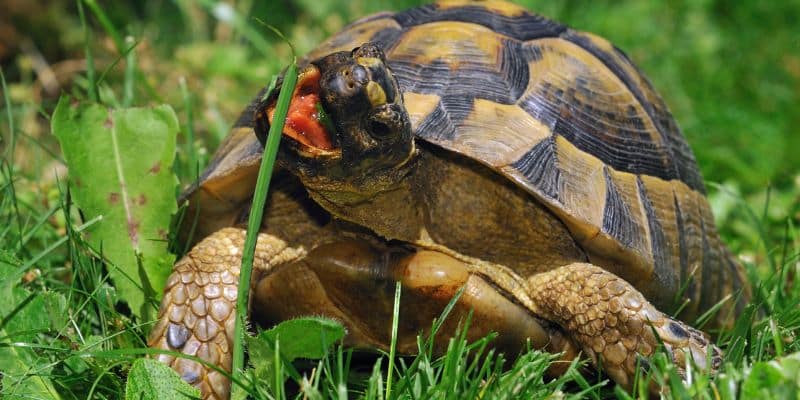
Hermann’s, Greek, and marginated tortoises come from Mediterranean climates with hot, dry summers and mild, rainy winters. Their natural diet consists largely of leafy greens and flowers with strong fiber emphasis, and they have seasonal adaptations that affect feeding.
Leafy Greens and Weeds (70-75% of diet): These should dominate the diet. Dandelion greens are high in fiber and calcium—a staple food. Endive should be fed as part of varied diet. Rocket (arugula) contains goitrogens, so feed in moderation. Turnip greens are rich in nutrients and low in oxalates. Mustard greens offer good nutrition but provide in moderation due to vitamin A content.
Wild weeds are particularly valuable: Plantain is nutrient-rich and commonly found in natural Mediterranean habitats—fine to feed regularly. Clover contains protein so feed sparingly as part of variety. Chickweed should be fed in moderation.
Flowers (10-15% of diet): Mediterranean tortoises naturally consume many flowers. Hibiscus flowers and leaves provide variety and vitamins. Rose petals are delicious treats when available—ensure they’re pesticide-free. Nasturtium should be fed in moderation due to high oxalate content.
Vegetables (5-10% maximum): Vegetables play a smaller role than many keepers realize. Carrot tops can be offered in moderation—they’re high in vitamins but lower in fiber than leafy greens. Zucchini flowers and fruit are fine, but avoid leaves and stems. High water content means avoiding excessive amounts. Bell peppers should be fed occasionally due to poor calcium-to-phosphorus ratio. Use fruit only—leaves, roots, and stems are toxic.
Fruits (Rare treats only): Mediterranean tortoises encounter minimal fruit naturally. Apples should be de-seeded and cut into small pieces. Melon should be offered only occasionally due to high sugar content. These are treats, not regular foods.
Calcium Supplementation: Regular calcium supplementation is crucial for Mediterranean tortoises to prevent shell deformities and promote skeletal health. Cuttlebone allows tortoises to self-regulate calcium intake and should be available constantly.
Low-calorie, high-fiber leafy greens and weeds must form the diet’s core. Edible flowers introduce natural antioxidants and vitamins while enhancing enrichment. Vegetables add variety and hydration but should be offered in moderation to prevent digestive issues. Fruits should be extremely limited due to high sugar content—small pieces as occasional treats only. And you can use our Vitamin and Mineral Topper to add nutritional value.
The Calcium-Phosphorus Ratio That Matters for All Tortoises
Regardless of tortoise type, calcium and phosphorus balance is absolutely critical. The ideal dietary calcium-to-phosphorus ratio for all tortoises should be 1.5:1 to 2:1—meaning at least 1.5 to 2 times as much calcium as phosphorus.
This ratio determines whether your tortoise can actually absorb the calcium you’re providing. Phosphorus and calcium compete for absorption in the digestive tract. When phosphorus levels are too high relative to calcium, it actively blocks calcium absorption even if you’re providing calcium-rich foods or supplements.
Calcium is essential for bone mineralization and shell development. Without adequate calcium, tortoises develop metabolic bone disease—soft, deformed shells (pyramiding), weakened bones prone to fractures, and improper organ function. Calcium also plays critical roles in nerve function, blood clotting, and muscle contraction.
The body attempts to compensate for low blood calcium by pulling calcium from bones, leaving the skeleton depleted and weak. This creates a vicious cycle where the tortoise’s structure literally breaks down to maintain basic bodily functions. Advanced metabolic bone disease leads to kidney disease, organ failure, and death.
To maintain healthy ratios, focus on foods naturally high in calcium and low in phosphorus. Dandelion greens, turnip greens, and mustard greens are excellent for all tortoise types. Avoid excessive high-phosphorus foods like spinach, beet greens, and certain vegetables that compete with calcium absorption.
Are You Starving Your Tortoise?
Save 10% on premium tortoise food and supplements from Tortoise Resource Center on Amazon now using code BUYNOWGET10

Sulcata Vitamin & Mineral Topper Supplement
30-Day Supply | 2 oz (56 g)
$24.99
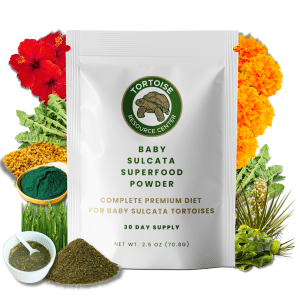
Baby Sulcata Tortoise Superfood Powder
30-Day Supply | 2.5 oz (70.8 g) Bag
$24.99
Foods That Are Dangerous for All Tortoises
Some foods are toxic or harmful regardless of tortoise type. These must be completely avoided for all species.
Toxic Flowers: Autumn crocus contains colchicine causing gastrointestinal distress and organ damage. Buttercup contains ranunculin causing irritation. Foxglove contains digitalin toxic to the heart. Hemlock is extremely toxic with coniine disrupting the nervous system and causing death. Lantana causes liver damage and failure. Oleander is extremely poisonous, causing severe cardiac issues. Rhododendron contains grayanotoxins affecting heart function. Yew contains taxine, highly toxic to cardiac systems.
Dangerous Houseplants: Dieffenbachia and pothos contain calcium oxalate crystals causing severe oral irritation. Philodendron causes difficulty swallowing and gastrointestinal distress. Sago palm contains cycasin, toxic to the liver and potentially fatal. Peace lily causes similar symptoms to dieffenbachia. Jade plant causes nausea, lethargy, and heart problems.
Toxic Garden Plants: Daffodils contain lycorine causing vomiting, diarrhea, convulsions, and nerve damage. Ivy contains saponins causing vomiting and abdominal pain. Euphorbia contains carcinogenic toxins with milky sap causing severe inflammation.
Dangerous Vegetables: Avocado contains persin, highly toxic causing heart damage. Rhubarb contains oxalic acid and anthraquinone glycosides causing kidney damage. Tomato plants (green parts) contain solanine—toxic. Potatoes, especially green parts and sprouts, contain solanine affecting nervous and digestive systems. Onions, garlic, and chives contain thiosulfates causing anemia. Corn on the cob contains excessive phosphorus, protein, and sugars that can ferment causing intestinal problems.
Problematic Leafy Greens: Spinach has high oxalate content that binds calcium and prevents absorption—avoid or offer extremely rarely. Cabbage, broccoli, and cauliflower contain goitrogens affecting thyroid function and potentially damaging liver and kidneys.
Harmful Grasses and Ferns: Bracken fern contains thiaminase breaking down vitamin B1, causing severe neurological disorders. Sorghum and Sudan grass contain cyanogenic glycosides that release cyanide. Foxtail grass has barbed seed heads causing physical injury and obstructions.
Supplementation for All Tortoise Types
Even with careful diet planning, captive tortoises rarely get the same nutritional variety as wild specimens grazing across diverse habitats. Supplementation fills these gaps and prevents deficiency-related diseases.
Before adding supplements, consult with a reptile veterinarian. They can assess your specific tortoise’s needs based on diet, environment, and any existing health concerns. Over-supplementation can be as harmful as deficiency, so professional guidance is valuable.
When administering supplements, sprinkle powder evenly on slightly damp foods so it adheres. Adults need supplementation 2-3 times weekly, while juveniles and breeding females require more frequent supplementation (4-6 times weekly). Observe for signs of lethargy or decreased appetite, which can indicate over-supplementation.
Quality matters enormously in supplements. Poor products often have incorrect ratios, inadequate bioavailability, or filler ingredients that don’t benefit your tortoise. Look for supplements specifically formulated for herbivorous tortoises, not generic reptile products designed for omnivorous species.
Age-Based Feeding Guidelines
Nutritional needs change dramatically as tortoises grow from hatchlings to adults. What works for babies causes problems in adults, and vice versa.
Juveniles (0-3 years): Feed daily with higher calcium supplementation than adults. Offer varied leafy greens and calcium-rich foods with vegetables finely chopped for easy consumption. Include calcium supplements 3-6 times per week depending on species and diet. Place varied food in front of your tortoise and allow eating for 20-30 minutes. Growth should be steady but not explosive—rapid growth causes pyramiding and organ stress.
Adults (3+ years): Feed every other day, especially fibrous plants that encourage natural grazing behaviors. Scatter food in different enclosure areas to encourage movement, enrichment, and natural foraging. Remove all uneaten food at day’s end. Calcium supplementation reduces to 2-3 times weekly.
Seniors (10+ years): Continue adult diet but reduce quantities as metabolism slows with age. Monitor weight monthly and adjust food amounts accordingly. Offer softer foods if dental issues arise, though this is rare in well-cared-for tortoises.
Feeding Strategies That Prevent Problems
Pet tortoises are prone to obesity, and excessive weight causes serious health problems including shell deformities, metabolic bone disease, liver disease, and joint stress. Preventing obesity requires proper diet composition and feeding strategies.
Weigh your tortoise monthly and schedule veterinary check-ups every 6-12 months to monitor body condition. If weight increases too rapidly or fat deposits become visible around neck and legs, reduce portion sizes and feeding frequency.
Create feeding enrichment by scattering food in multiple locations rather than piling it in one spot. Hide favored foods under leaves or behind obstacles. Plant edible vegetation directly in the enclosure for natural grazing opportunities. Create substrate mounds, place rocks and shelters strategically to make the enclosure interesting and require movement during feeding.
This prevents behavioral problems that develop in bored, under-stimulated tortoises. A mentally engaged tortoise with foraging opportunities is healthier and happier than one that gets everything delivered to a single dish.
Species-Specific Considerations
While the three main categories (desert, forest, Mediterranean) cover most common pet tortoises, some species have unique requirements.
Leopard tortoises: Follow desert tortoise guidelines but can handle slightly more variety in vegetables. They’re grazers like sulcatas but from slightly less arid regions.
Pancake tortoises: Follow desert guidelines but need more protein than typical desert species due to their unique metabolism and active lifestyle.
Box turtles: Often confused with tortoises but are actually omnivorous turtles requiring completely different diets including animal protein. Don’t follow tortoise guidelines for box turtles.
Giant tortoises (Galápagos, Aldabra): Follow general herbivorous guidelines but with massive quantities. These giants require enormous amounts of vegetation daily.
If you’re unsure which category your tortoise fits, research its natural habitat. Desert = primarily grasses. Forest = varied vegetation including some fruit and occasional protein. Mediterranean = leafy greens and weeds with seasonal variations.
Ready to Master Tortoise Nutrition?
Getting tortoise diet right isn’t just about avoiding immediate health problems—it’s about providing the nutritional foundation for 50-100 years of healthy life. The diet you provide determines whether your tortoise develops a strong, properly-formed shell or a deformed one. It determines whether their organs stay healthy or fail prematurely. It determines whether they’re active and thriving or lethargic and struggling.
The good news is that proper tortoise nutrition becomes second nature once you understand the principles. Identify whether you have a desert, forest, or Mediterranean tortoise. Focus on habitat-appropriate foods. Maintain proper calcium-to-phosphorus ratios. Avoid the temptation to treat them like omnivorous pets. Provide consistent, species-appropriate feeding throughout their lives.
Want even more detailed guidance on perfecting your tortoise’s diet? Sign up for our free bonus pack and get instant access to comprehensive nutrition guides including detailed meal plans, seasonal feeding schedules, troubleshooting guides for picky eaters, and shopping lists for optimal tortoise nutrition. Plus you’ll get growth tracking charts, discount codes, and expert tips for raising healthy tortoises of all types.
Your tortoise is counting on you to provide the nutrition they need to thrive for decades. With the right knowledge and consistent application, you can give them exactly that.
